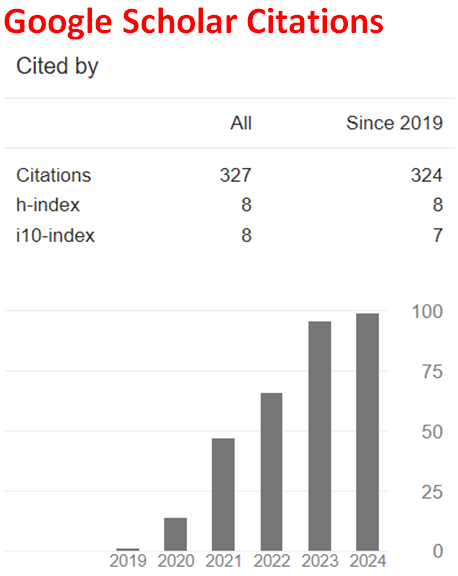On the chemical oxidation of berberine
Abstract
Berberine is an antiseptic isolated from several plants. Klunge proposed a test for identification of this four ring isoquinoline alkaloid. He used a solution of berberine, chlorine water and hydrochloric acid or sulphuric acid, obtaining a red colour. In this communication the reaction route to the oxidation product is described. There is a ionic mechanism that ends in a red ortho-benzoquinone. The key intermediate displays an organic hypochlorite and a hemiacetal with a hydroxymethyl group. The reactive species in this oxidation process is hypochlorous acidium ion. Finally, interaction with a hydrion degrades the molecule, giving a red o-benzoquinone, the colour observed in the test, plus formaldehyde. The quinone has been obtained by electrochemical oxidation of berberine, a much more complicated method than a simple and rapid chemical test. A second oxidation product was obtained electrochemically, involving oxidation of the methylene in the five member ring to carbonyl. We provide a synthesis of this compound.
Downloads
References
Berberine. Merriam Webster Dictionary. https://www.merriam-webster.com>berberine
Oregon Grape. https://sites.evergreen.edu>oregon-grape
Sánchez-Viesca, F., & Gómez, R. (2024). On apomorphine detection by colour reactions. Journal of Chemical, Biological and Physical Sciences, 15(1), 001-005. https://doi.org/10.24214/jcbps.A.15.1.001
Sánchez-Viesca, F., & Gómez, R. (2024). A novel transamination reaction in a murexide-like sequence for caffeine detection. Earthline Journal of Chemical Sciences, 11(3), 437-444. https://doi.org/10.34198/ejcs.11324.437444
Sánchez-Viesca, F., & Gómez, R. (2024). A complete and sustained organic/inorganic reaction mechanism of Baeyer´s test. World Journal of Chemical and Pharmaceutical Sciences, 4(2), 1-5. https://doi.org/10.53346/wjcps.2024.4.2.0023
Sánchez-Viesca, F., & Gómez, R. (2024). Mechanism of the interaction of alkaline tungstate with uric acid. Journal of Chemical, Biological and Physical Sciences, 14(4), 311-315. https://doi.org/10.24214/jcbps.A.14.4.31115
Sánchez-Viesca, F., & Gómez, R. (2023). On the chemistry of Beckurt’s test for physostigmine: A novel hydride transfer. Magna Scientia Advanced Research and Reviews, 08(02), 022-025. https://doi.org/10.30574/msarr.2023.8.2.0098
Merck, E. (1903). Merck’s reagentien verzeichnis (p. 78). Darmstadt: Springer. https://doi.org/10.1007/978-3-642-99730-3
Cohn, A. I. (1903). Tests and reagents (p. 158). New York: J. Wiley & Sons.
Beyer, H. (1963). Organic chemistry (p. 674). Frankfurt/Main & Zurich: H. Deutsch.
Heilbron, I., & Bunbury, H. M. (Eds.). (1953). Dictionary of organic compounds (Vol. 1, p, 285). London: Eyre & Spottiswood.
Fieser, L. F., & Fieser, M. (1956). Organic chemistry (3rd ed., p. 832). New York: Reinhold.
Sykes, P. (1967). Mechanism in organic chemistry (p. 107). London: Longmans
Francisco, J. S., & Sander, S. P. (1995). Protonated hydrochlorous acid (HOClH+): Molecular structure, vibrational frequencies, and proton affinity. Journal of Chemical Physics, 102(24), 9615-9618. https://doi.org/10.1063/1.468778
Egsgaard, H., & Carlsen, L. (1992). Hypohalous acidium ions. International Journal of Mass Spectrometry and Ion Processes, 113(3), 233-240. https://doi.org./10.1016/0168-1176(92)85012-O
Teitel, S., O’Brien, J., & Brossi, A. (1972). Preferential cleavage of an aromatic methylenedioxy group in the presence of methoxyls with boron trichloride. Journal of Organic Chemistry, 37(21), 3368-3369. https://doi.org/10.1021/jo00986a046
Adaeva, O. I, Demchuk, D. V., & Semenor, V. V. (2023). 6,7-Dihydroxy-5,8-dimethoxy-2H-chromen-2-one. Molbank, 3, M1702. https://doi.org/10.3390/M1702
Beyer, H. (1963). Organic chemistry (p. 402). Frankfurt/Main & Zürich: H. Deutsch.
Heilbron, I., & Bunbury, H. M. (1953). Dictionary of organic compounds (Vol. 3, p. 566). London: Spottiswood.
Heilbron, I., & Bunbury, H. M. (1953). Dictionary of organic compounds (Vol. 4, p. 525). London: Spottiswood.
Diculescu, V. C, Enache, T. A, Oliveira, P. G., & Oliveira-Brett A.M. (2009). Electrochemical oxidation of berberine and its oxidation products. Electroanalysis, 21(9), 1027-1034. https://doi.org/10.1002/elan.200804516

This work is licensed under a Creative Commons Attribution 4.0 International License.


